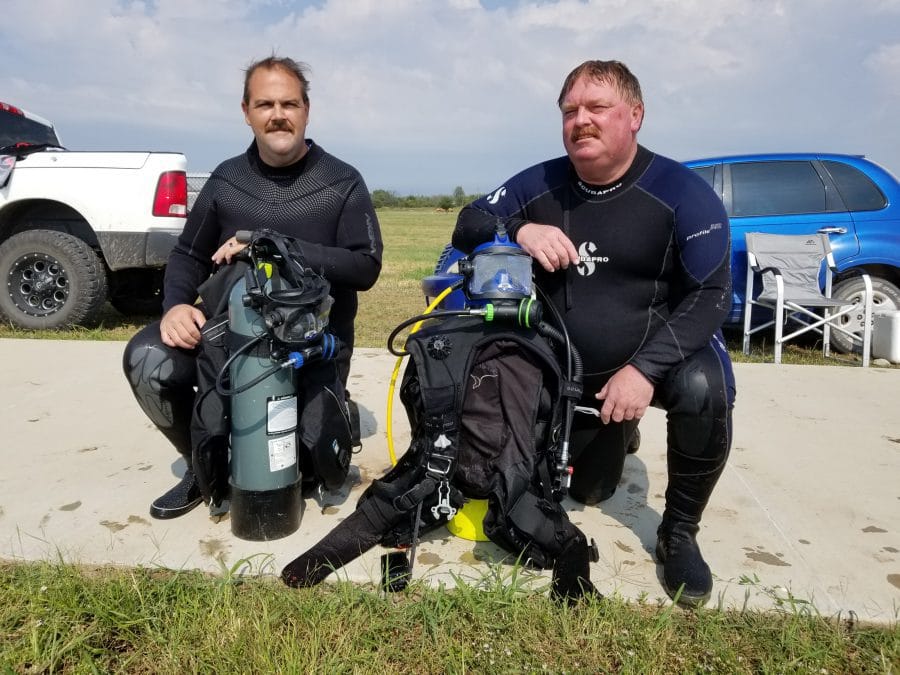Considered a renewable resource by the U.S. Environmental Protection Agency, geothermal heating, ventilation and air conditioning systems utilize the temperature differences between the ambient air and the stable heat underneath the earth’s surface, which results in fewer pollutants than other energy creation methods.
On the forefront of technology and environmental awareness, Citizen Potawatomi Nation built geothermal ponds to heat and cool some of its largest buildings. However, after several years of use, the components that sit in those ponds became less efficient.

In 2016, the Tribe sent scuba divers to the bottom of FireLake lake to assess the situation. Chris Berry, a recreational scuba diver and security guard at CPN Health Services East Clinic, took part in the first discovery expedition. It showed a manageable issue with the heat exchangers, the components that absorb or disperse the heat needed to achieve the desired temperature.
“We went down, took pictures, showed them, ‘Hey, they are basically just blanketed in this algae, and there’s no way that they can dispense the heat like they’re supposed to,’” he said.
He and Eric Reed, conservation law enforcement officer for the CPN Department of Realty, began cleaning the heat exchangers in 2016. They dove together in the geothermal pond for the third time at the beginning of October.
“We do a good job for the Tribe. We get them as clean as we possibly can and that way they work as long as they can until the overgrowth takes them over again, and we have to come back out and clean again,” Berry said.
After several attempts to find a cost effective and environmentally friendly solution to the algae buildup, scuba divers with scrub brushes met those standards the best.
“They could use chemicals, but it would kill every living thing in the pond. And the chairman (John “Rocky” Barrett) does not want that. He wants the wildlife not to be harmed at all. That’s why we do the scrub job on them. That’s the safest way for the environment,” Berry said.
Both Berry and Reed consider themselves outdoorsmen and animal lovers, and they enjoy contributing in a protective way.
Equipment above and below
Scuba gear is heavy; an 80 cubic foot tank weighs between 40 and 50 pounds. With the additional weights required to help them sink to the bottom of the pond, Berry and Reed carry approximately 75 pounds each. They ease suiting up by taking the tanks into the water before strapping them to their bodies, allowing the buoyancy to do the heavy lifting.
Eight heat exchangers sit in the pond, and the divers spend an average of three hours on each one. They take breaks between plunges to allow the pressurized gas in their bloodstreams to escape at a natural pace.
One tank allows for a 50 to 65 minute dive. However, their physical exertion increases their air use, which reduces their time underwater. Reed and Berry keep track of their intake with digital monitors on their wrists.
“Scrubbing that stuff’s not easy and controlling your breathing at the same time,” Berry said. “It’s not like running and jogging. You have to control what you’re using because you’re limited on how much you can use.”
To clean the geothermal equipment, Berry and Reed head 20 feet under the surface to the base of the exchangers, which are 7 or 8 inches off the ground. They can see 12 to 15 inches around them in the murky water, and the scrubbing significantly reduces their field of vision.
“The algae comes up, and it’s like a snow effect, and it blocks a lot of your vision. And sometimes you can get disoriented and a little bit dizzy if you start watching that floating around in front of you,” Reed said.
“The fish come up to you to your mask and swim around in front of you. And sometimes you can reach out, and they’ll get up in the your palm of your hand and kind of just hover there. It’s pretty neat, pretty exciting.”
They take pictures of their work under the water and keep track of the algae’s growth.
Beginnings
The two met while working for the Tribe and became good friends through scuba diving. Berry began diving after knee surgery as low-impact recreation and exercise and became a certified rescue diver nine years ago.
He introduced Reed to Scuba Dudes dive shop in Shawnee, Oklahoma, where he learned. After witnessing events following a drowning at the Shawnee Twin Lakes, Reed felt the need to become certified as a service to the community.
“The rescuers come out there, and they said it would be 45 minutes for somebody to come out from (Oklahoma City) to help retrieve the body that was underwater,” he said. “I just thought that was ridiculous that there wasn’t anybody in Pottawatomie County that would be available to assist in that type of emergency.”
Reed enjoys it as a hobby as well.
“It’s just altogether a stress reliever to get under water,” he said. “The only noise you have is the bubbles from your exhaust coming out of your regulator, and it’s just peaceful.”
They both serve as part of the CPN Police Department’s dive team and take scuba vacations together with larger groups of people. Cozumel is one of their favorite destinations. They also find places to hit the water in Oklahoma, including Lake Tenkiller and Lake Murray.
“Just anywhere there’s clear enough water to enjoy yourself,” Berry said.
